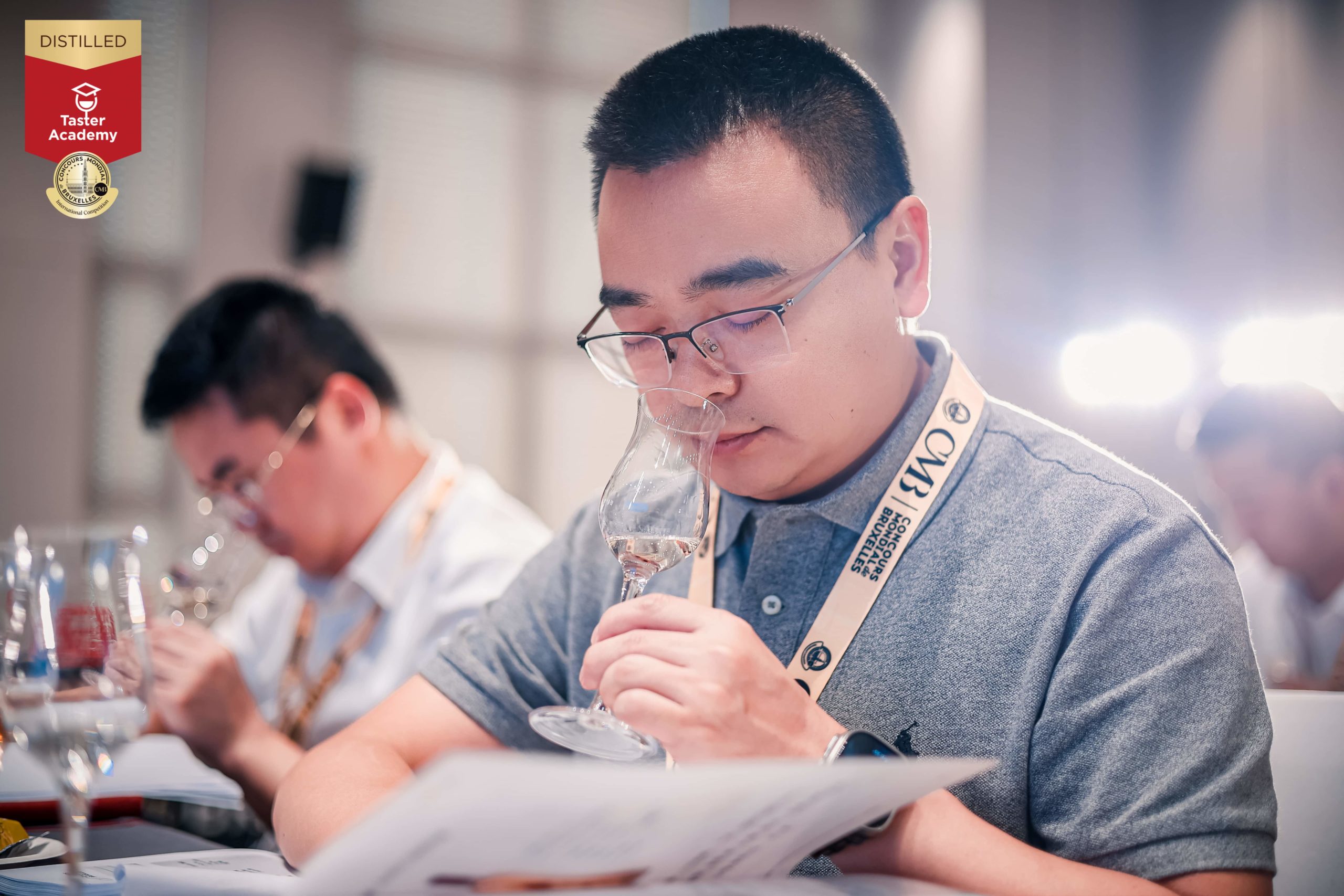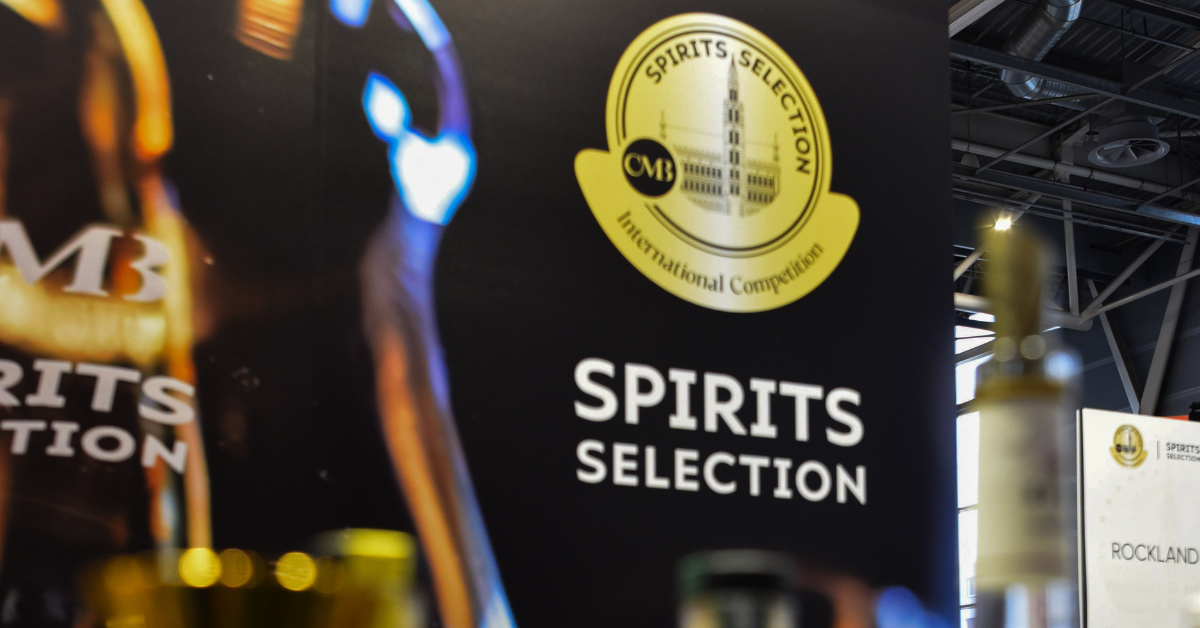From food beverage to cocktail ingredient – fruit brandies struggle to find their niche
Fruit spirits are luscious and – by definition – completely natural products. “They tick all the boxes required today by consumers: small producers, local cultures for many, artisanal manufacture, discontinuous distillation, the promise of “as close to nature”, of the human behind the still”… says Christine Lambert, in an article published in whiskymag in January 2020. In Western Europe, the category is struggling to resurface, while in South-East Europe, demand is growing and producers are expecting higher demand over the next five years. But why are there such marked differences between markets? We conducted a small survey among producers and category specialists, and met with producers from Serbia and Bosnia Herzegovina.
I was recently able to travel to Serbia and Bosnia-Herzegovina, to meet some of the most renowned fruit spirits distillers. In the Balkans, fruit spirits are the first category of alcohol consumed, well before any other category. While in France, for example, whisky is the leading category with nearly 200 million bottles consumed, fruit spirits represent only 0.4% of consumption. Why such marketed differences between markets. This is what led me to want to know more.
In the Balkans, “rakia” is the term used to describe this extensive category of spirits, which can be made from grapes (often aromatic), grape pomace, a blend of both, or other fruits. There are therefore a multitude of sub-categories, none of which should be mistaken for the anise-based raki.
In Bulgaria and Macedonia, grape brandies are the most widely drunk, whereas in Serbia and Bosnia, plum, quince, Williams pear, apricot, and raspberry brandies are the most popular. Here, rakias are part of the food culture, and are still consumed by all generations. Rakia is a social drink, which is associated with sharing with friends. This encourages restaurants to serve it, because it makes people spend money. Also, because rakia pairs very successfully with food (salads, cured meats, cheeses..), it can be drunk with every course of lunch or dinner. And everyone in the Balkans will tell you that rakia is the only spirit that goes well with food. In Bulgaria, as the gourmet food culture gains traction, its consumption is increasing.
One of the trends witnessed in Serbia, Bosnia and Bulgaria is growth in demand for barrel-aged fruit spirits – plum, quince, apricot and even Williams pear – which has literally gone through the roof. The tendency among consumers to drink less but better gets them reaching for more mature, higher-end spirits, which are considered to be more flavourful and complex. They are accustomed to drinking barrel-aged spirits, which match well-known cues, and this is opening up a window of opportunity for premium fruit spirits across-the-board. Fruit spirits have an extremely high potential for complexity. “The purist will prefer ageing in a glass demi-john”, says Bernard Baud, chairman of the French fruit spirits producers. “But if barrel-ageing is what it takes to secure legitimate quality credentials, then let us adapt to the market”.
Interestingly, in Serbia, it is quite common for rakia to be drunk neat in dancing clubs.
Rakia production in Bulgaria and Serbia: contrasting situations
In Bulgaria, rakia is mainly made from grapes, but domestic wine production has fallen sharply, because people have turned to entry-level box wines. At the same time, the country’s production of good quality home made rakia is in sharp decline due to the disappearance of good, experienced distillers who are no longer passing on their heritage. Also, it is forbidden for individuals to sell the rakia they produce.
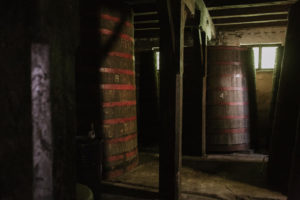
In Serbia and Bosnia, consumption of rakia, particularly fruit-based versions, is higher and growing. It is also forbidden to sell one’s own production, but a licensed producer can be used to sell products, which is easier if the quality is good.
Producers in these regions are confident, export demand is booming, particularly for apricot rakias, and barrel-aged quince and plum versions.
In Western Europe, fruit brandies are no longer popular with consumers, who drink whisky, gin, rum and vodka, mostly in the form of cocktails. Brandies are generally consumed as a post-prandial drink after a hearty meal, but this pattern of drinking has declined sharply. Also, the category is perceived as “hard liquor” (“alcool fort “in French) due to the history of fruit brandy, which was initially used as medication. It carved out a place for itself in traditional medicine for treating high fever and improving blood circulation and skin diseases, for example. So it was considered as “strong alcohol” for its usage.
For a long time, faulty products were relatively commonplace (bad mashing, foreshot/faints…) because the production remained very artisanal and practiced by each household in the countryside. The fruit brandies had a reputation for burning the palate, and this image still persists today. There are still a lot of low quality products and often non-genuine products on the market, dashing consumers’ expectations, and resulting in this perception of “strong alcohol. Unfortunately, these are also the most popular products. Even now, most people’s experience stems from a local distiller’s products. And because it’s local, people cherish it but it is not very highly regarded, and often has faults that you will never find in gin (“nice, but it was made by my sister’s cousin, so it can’t be real quality, it doesn’t even have a label!”). And that impression carries over to ‘professional’ products.
In all the areas where fruit brandies are portrayed (cinema, literature…), the category is always associated with an experience where the brandy burns or hurts. This is even true of recent movies, where each time a fruit brandy is used, it is to underline something comical. This is the myth of Sisyphus – “You go down the hill and you have to climb up again and again” says Bernard Baud. “Even journalists in the mainstream press have a hard time seeing the category as modern. Often, when the brandies get into mainstream articles, they’ll talk. Getting the word out about fruit brandies is challenging, because there is background noise in the market that captures consumers and directs them towards gin, vodka, whiskey and rum, where communications are extremely hard-hitting.”
Brandy producers struggle to be heard, and are immediately pigeonholed into traditional, old fashioned boxes.
Also, the category is not allocating marketing/sales resources effectively. Most brandies are still presented in old fashioned packaging, sometimes intentionally by the producers who want to support this “traditional” image. There is a lack of creativity and communication.
The market comprises a raft of small and medium distilleries. The major players have no fruit spirits in their portfolio because the category is a long way off success and has yet to realize any market potential.
Could fruit spirits in cocktails offer an alternative?
Despite the revival of the cocktail scene around the world, fruit spirits in general are not widely used in cocktails. Bartenders are encountering reluctance from consumers when presented with a cocktail containing Williams pear, apricot, quince or plum brandies. There is a revival of heritage cocktails, but there has never been a cocktail, even a heritage one, that introduced brandies. “In Bulgaria, rakia cocktails are very popular”, says Svetlin Mirchev, an importer and distributor of rakias in Sofia (The RakiaSHOP), “we are very proud with that. Almost every good bar works with rakia and the cocktails are very well accepted.”
“Consumption in the form of cocktails is a solution, but first bartenders and sommeliers need to be educated” confirms Bernard Baud. Not just simple cocktails but elaborate ones by modern, expert bartenders. Consumers nowadays are looking for pleasure and surprises. Bartenders need an excuse to put fruit brandy in a cocktail, and then say to consumers who enjoy it, “..well, there is a fruit brandy in this cocktail…”. The next step is to tell the story about the brandy, its provenance and traditions. And then the consumer may ask to taste it neat.
Specific fruit varieties for distillation?
For plum brandies, the most commonly cited varieties in Bulgaria are ‘Stanley’ and ‘Chachanska lepotitsa’ or Jo-jo, while the traditional noble variety is called Troiansla sliva, but it is almost extinct due to a disease. In Serbia, the traditional noble varieties are , ‘Pozegaca’, ‘Red Ranka’ and ‘Trnovaca’ while ‘Stanley’ distillates are used for blending. The lack of a genetic analysis program at European level offers little visibility on fruit types. The producers I interviewed said that they use the fruit available to them and have experience with, without knowing whether it is the most suitable variety.
Most of the varieties, and this is true of any kind of fruit, are on the verge of becoming extinct. And the reason is simple says Bernard Baud. “Any fruit grower who decides to plant needs to balance the books. And this is based on the combination of 3 profitability factors. When a fruit grower plants a tree, he knows that he will make 70% to 80% of his profits in the fresh fruit market, and 10 to 20% from the transformation of fruits into juice and concentrates. The distiller comes after. In many European countries, there are no more processors and the table fruit market has collapsed because of all kinds of imports. There is no more profitability for the distilling varieties. To plant an orchard today with a distilling variety that has no outlet in the fresh/table fruit market and is only suitable for distillation is almost suicidal. The brandy would have to be sold at prices that the consumer is not willing to pay”.
Exciting discoveries in Serbia and Bosnia
The numerous spirits tasted during this trip organized by Svetlin Mirchev deserve to be included in a catalogue of the best fruit spirits. But unfortunately, this is not possible in a single article. I will therefore focus on providing some insight into the distilleries I visited and my favourite picks.
Hubert1924 – Kikinda – Serbia
This distillery dates back to 1924, and was bought by two investors in 2007, who were passionate about fruit brandies but dissatisfied with the current choice available. Rakia was then mainly consumed by people in rural areas. Over the past fifteen years or so, a noticeable improvement in the quality of Serbian brandies has occurred and some great distilleries have emerged.
The cellar master comments: “The right varieties of fruit need to be chosen as this makes up 70% of the quality of the end product. We are still a young distillery, we do not have enough old plum distillates. This fruit brandy deserves lengthy ageing”.
Hubert farms 15 hectares of quince, apricot and plum orchards. “But we lack fruit and we buy Williams pears and apples. We are increasingly encountering problems with apricots. Here, the winters start later and end later, which is very bad for growing apricot trees, and causes a drop in yields. We did not harvest any apricots in 2020″.

That’s a crying shame because the distillery’s apricot brandy – Kajsija – won a grand gold medal and a Revelation trophy at Spirits Selection 2019.
Upon harvest, the fruits are stored at low temperatures, but no longer than 4-5 days. Fermentation is carried out at 16-18°C. Specific yeasts and enzymes are bought to maximise sugar transformation. The fermented musts are distilled directly (double distillation), which means that the timing of the fermentations has to be good. The distillery is equipped with 3 stills with a capacity of 300 litres, and one of 750 litres, all with a direct fire (gas).
Destilerija Hubert1924 – Dunja (Quince – aged in barrels)
Great elegance, finesse and complexity on the nose, with floral and quince zest notes. On the palate, fruit with notes of coffee, cacao, vanilla and coconut.
Destilerija Hubert1924 – Viljamovka – Williams Pear
A blend of the 2019 and 2020 brandies. It is clean, very aromatic and elegant on the nose. The palate is smooth and satisfying but also crisp with a long finish.
Stara Pesma – Bajina Basta Region – Serbia
This family business is located in a beautiful valley, facing the Tara and Povlen mountains. The south-facing orchards benefit from the broad diurnal shift, which maximises fruit aromas. Until 2004, only plums were distilled. In 2012, Stara Pesma added quinces, apricots, Williams pears, blackberries and raspberries to its range. The distillery is witnessing good sales growth, especially in Serbia.
Double distillation is carried out in wood-fired stills and the brandies are matured mainly in 500-litre barrels.



Stara Pesma – Old Song – Raspberry
Serbia is the leading producer of raspberries in Europe. The countryside in this area is dotted with small plots of raspberry trees. 15 to 20 kg of Villamette variety raspberries are needed to produce one litre of 40% ABV raspberry brandy. This is a brandy produced by fermentation, and not by maceration as in most cases.
The nose is clean and appealing with a core of fresh raspberry. There are no flaws, which would be noticeable, because this is a very delicate fruit, where mistakes are unforgiving. The palate is rounded, pleasant and smooth. This is a magnificent brandy.
Stara Pesma – Old Song – Plum 7 years in barrels
Plum rakias are aged for 12 years at most in barrels, then returned to stainless steel tanks. Three labels are marketed: 5 -7 and 12 years. My favourite is the 7-year-old brandy. It has a nose of caramelised plum cake, a smooth and elegant palate, and sweet spices on the finish.
Stare Pesma – Old Song – Aged Apricot
Apricots collected at the peak of ripeness spend 2 to 3 years in barrels. The very intense apricot edge is traded for richer, moreish honeyed and vanilla notes. The same impression recurs on the palate, which is smooth, honeyed and vanilla-like with a stronger butterscotch candy flavour.
Destilerija Zaric – Kosjeric – Serbia
The distillery dates back to 1946 and is located in a region renowned for its raspberry production. It is equipped with an Italian Cadalpi pot still, fitted with a small column, but also a Charente-style pot still.
A specific feature of plum rakias is that the seeds of the fruits are removed before fermentation. Ageing is carried out in large tuns for an average of three years (much longer for the plum) using a technique that can be likened to the ‘solera’ system. Each year approximately 1/3 of the contents are removed, filtered and then bottled or moved to stainless steel tanks to preserve the fruit profile. The tuns are then filled with the same volume of white brandy. Before being placed in the tun, the distillate, depending on the circumstances, spends around 3 to 6 months in temperature-controlled stainless steel tanks to harmonise and stabilise the brandy. The liquor undergoes sudden variations in temperature, positive and negative, in order to isolate the fractions, flocculate the organic residues, and cause oxidation. The principle consists of imitating and accelerating the ageing process as it was traditionally practised by storing the fruit spirits in attics, subjecting them to the negative temperatures in winter and hot temperatures in summer.
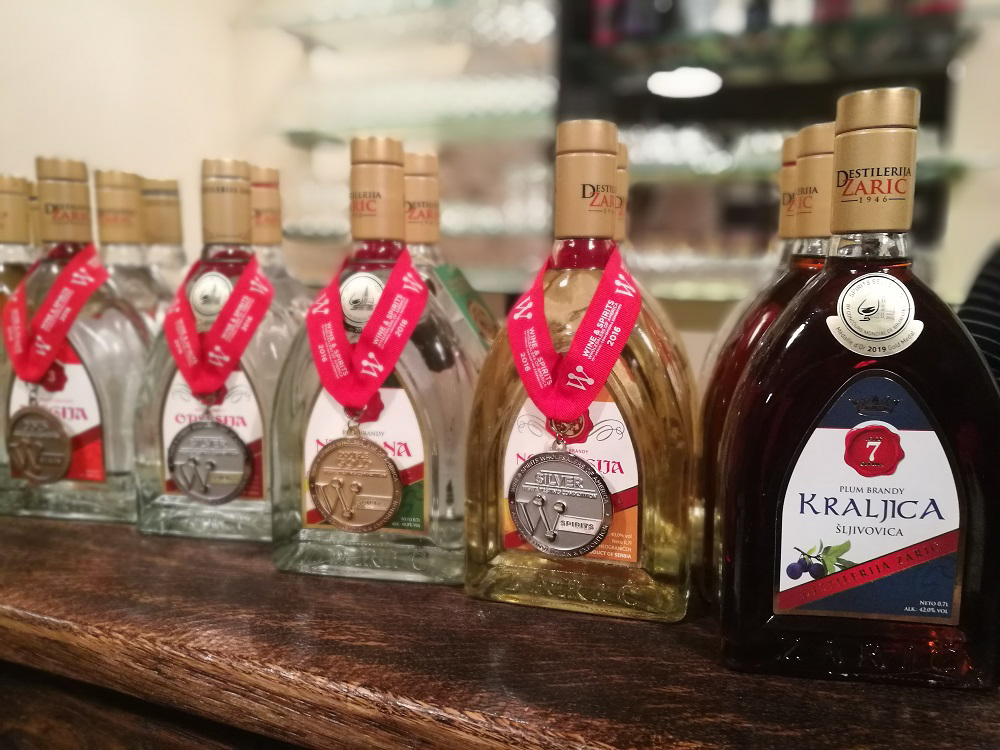


Nirvana – Williams Pear – Serbia – Destilerija Zaric
Matured for two years in stainless steel vessels. The nose is very expressive and driven by ripe pear. The palate is soft and warm, gentle and subtle, extremely fruity, very long and driven by pear and pineapple. You can really feel the granular texture of the pear. This is a real gem in the category. The panel at Spirits Selection 2020 awarded it a grand gold medal and a Revelation trophy.

Kralj Plemenito Pice – The King – Old Plum – Serbia – Destilerija Zaric
This is the ultimate in plum rakia, produced in very limited quantities. Just 500 bottles are made every 5 years and the brandies are bottled in Swarovski crystal bottles and are at least ten years old. Only the juice of the fresh plums is sent to the fermentation vessels.
It shows incredible richness yet freshness. The nose delivers floral aromas, fresh plums, cocoa beans, coffee, almond, candied grapes and apricots notes. It is extremely juicy on the palate with a thick and creamy texture. The enjoyment you get from tasting it is akin to savouring a Château d’Yquem.
It’s not for everyone, but there is also a more affordable version – the Kraljica 7-year-old version (The Queen) – that I highly recommend. The Queen is produced from the finest plum varieties, “Pozegaca, Crvena Ranka and Trnovaca” and has a Protected Geographical Origin. A Gold Medal at the Spirits Selection 2019.
SZR Zlatna Dolina – Serbia

This is a very small and traditional distillery located in an oasis of orchards. When you see the very rustic facilities, the quality of the spirits produced is even more amazing.
A few wooden vats that have already seen many a brew are used for fermentation. Distillation is carried out in an old, classic Lampek 180-litre still and ageing in 450-litre and 500-litre oak barrels.

Zlatna Dolina Quince
Matured for 3 years in 500-liter oak barrels this spirit demonstrates aroma and taste of very well ripe quince and quince peel. Those are very well harmonized with gentle notes of oak extraction like vanilla, chocolate, caramel. Awarded with a Gold medal at Spirits Selection 2019.
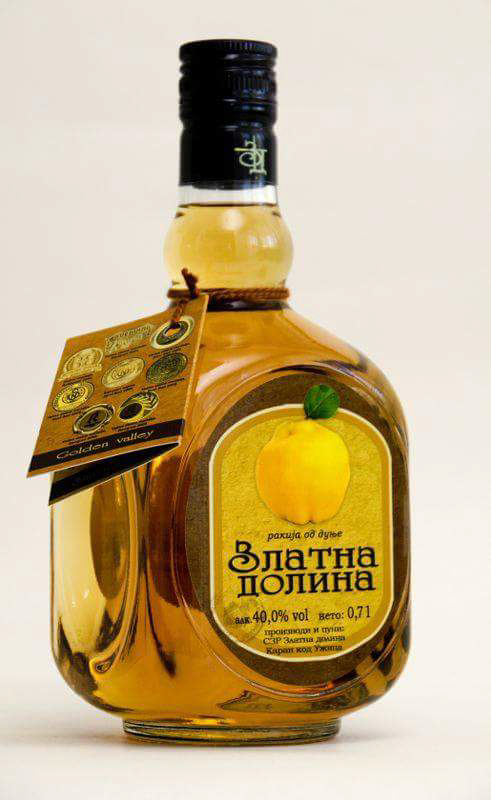
Zlatna Dolina Golden Valley 12 years – Old Plum – 70 cl
Extremely high level of complexity. Very good multy component oak extraction harmonized very well with the perfectly preserved fruit aroma and taste – coffee, chocolate, cacao, tea leaves, black olive. Fresh on the palate while at the same time mineralic and spicy on the aftertaste.
The owner takes a sample of plum brandy straight from the cask – it is 32 years old. Words cannot describe the sensation – it is simply incredible, with such roundness and richness!
Destilerija Monogram – Donji Skugric – Bosnia Herzegovina
The Monogram distillery complex stretches over 30 hectares of fertile soil, 20 hectares of them planted to apple and pear orchards. The distillery also buys plums, apricots and quinces from other parts of Serbia where the climate is more suitable for growing the fruits. Hidden among the orchards is a 4*hotel and a restaurant.
The production facilities are extensive, with fridges to store table fruits, but also equipment to process and transform all the fruit into jams, chips – and of course fruit spirits.


Monogram Quince
Matures for 4 years in oak and presents notable intensity and complexity in the aroma and taste. The quince aroma combines very well with intense maturation effects. The classic for a quince rakia geranium aroma is combined with notes of walnuts, green walnuts, and honey. The taste is long lasting and literally exploding on the palate, and is followed by taste and aroma of tea leaves and ginger. Awarded a silver medal at Spirits Selection 2019.

Monogram Viljamovka Barrique
Oak matured Williams pear rakia with excellent aroma, followed by an intense and mouth filling taste of Williams pear. The fruit is very well expressed in the aroma and literally explodes on the palate. The Williams pear is perfectly complemented by subtle notes of vanilla, caramel and coconut coming from the oak maturation.

